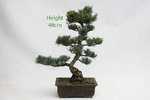Fridge
Yamadori
Hi all you bonsai experts
I bought this Japanese white pine a couple of years ago and have been letting it grow freely except a bit of pinching on the candles. It is my first bonsai and I did not pay a huge amount of money for it. I know it has pretty bad bite marks in the trunk and I'm sure there are a lot of other flaws which could be pointed out, but I have get a lot of enjoyment from it and am excited to see how it develops
The tree is around 15 years old and my aim with the tree is to grow it larger over many years. I like the look of the slightly larger trees and have attached an image of what I want to go towards in the next stages (years) of its growth. I do like the look of the large canopy on the first branch and (as everyone) would love a thicker trunk
As a beginner my main priority is that the tree grows healthily and fills out with age. I have not done any kind of wiring or pruning of branches yet on the tree but I think I need to do so later this year
I was hoping to get your feedback on the following
* If my main priority is simply to grow the tree healthily and bigger should I simply leave it to grow?
* Should I flatten out the lowest canopy with some wiring and start to flatten out a canopy on the opposite side to this but slightly higher up the tree?
* The tree was last re-potted around 2-3 years ago - should I put this in a larger pot if I want to grow it larger?
Please let me know if the pictures I attached are no good!
Apologies for all the newbie questions but I'm excited to start taking a more active part in shaping the tree, and would appreciate any feedback!
Thanks
Fred
I bought this Japanese white pine a couple of years ago and have been letting it grow freely except a bit of pinching on the candles. It is my first bonsai and I did not pay a huge amount of money for it. I know it has pretty bad bite marks in the trunk and I'm sure there are a lot of other flaws which could be pointed out, but I have get a lot of enjoyment from it and am excited to see how it develops
The tree is around 15 years old and my aim with the tree is to grow it larger over many years. I like the look of the slightly larger trees and have attached an image of what I want to go towards in the next stages (years) of its growth. I do like the look of the large canopy on the first branch and (as everyone) would love a thicker trunk
As a beginner my main priority is that the tree grows healthily and fills out with age. I have not done any kind of wiring or pruning of branches yet on the tree but I think I need to do so later this year
I was hoping to get your feedback on the following
* If my main priority is simply to grow the tree healthily and bigger should I simply leave it to grow?
* Should I flatten out the lowest canopy with some wiring and start to flatten out a canopy on the opposite side to this but slightly higher up the tree?
* The tree was last re-potted around 2-3 years ago - should I put this in a larger pot if I want to grow it larger?
Please let me know if the pictures I attached are no good!
Apologies for all the newbie questions but I'm excited to start taking a more active part in shaping the tree, and would appreciate any feedback!
Thanks
Fred










